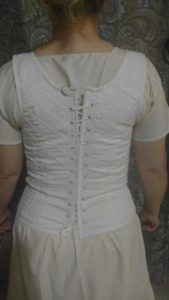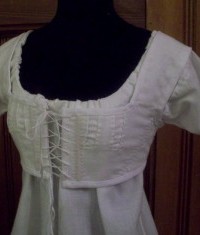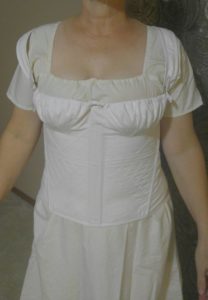
The cotton twill fabric is stiff and tightly woven to inhibit penetration of the corset’s boning which is called stays and what gives this garment its name. Both Twill and Coutil have a high cotton which has good dimensional stability, or a resistance to stretching, which makes it a good choice for clothing, and especially such as a stressed garment. My grommets are metal, but authentic Regency stays have stitched button holes. Some day, when I have nothing better to do, I will hand stitch around my grommets to make them look more authentic.
As you can see, I am wearing my stays over another garment called a shift, or chemise. You can read more details about it here.

Regency corset stays are quite comfortable. They don’t pinch. It’s simply not possible. Unless the boning is working its way out, they don’t poke. Unlike Victorian corsets which can be tightly laced, Regency stays don’t make it difficult to breathe. With the exception of the mid to late 1800’s, corset stays were not designed to give women a small waist, but to lift the bustline, and to give women a smooth base for clothes. In fact, until the introduction of the metal grommet (1828) and the 2 part metal busk (1829), tightening a corset enough to dramatically change one’s figure was nearly impossible. The fabric or the holes would have given out first. The corset merely provided the right silhouette for the loose, flowing gowns of the Regency.
If your heroine doesn’t wear stays, she’s not going to be able to wear the clothes of her era. At least, not with any class. She would look frumpy in them. Even if she chooses to wear them loosely laced, she would still be wearing them. Just as women today look either saggy or trashy (or both) when they walk around in public without a bra, so too, would a Regency woman.
While corsets are not uncomfortable, they do restrict the wearer in ways you may, and may not, expect.

Now, there are a few possible discomfort factors. Other stays wearers tell me they sometimes have tiny indentations from where the shift underneath the stays has creased the skin. These may itch a little for a few minutes. Rubbing them helps, I am told, but I’ve never had this problem.
If you lose weight, your corset can become uncomfortable—more so than if you gain a bit, as your breasts may slide down and get “squashed”. Plus, if it’s loose, it may rub.
If the boning works out of the channel at the top or bottom, it can jab but that won’t happen if it’s well made.
Overall, Regency stays really are quite comfortable and nice to wear. My main gripe is how long it takes to get into them, and that I can’t do it by myself. Otherwise, I’d be tempted to wear stays every day instead of a bra.
Regency Stays: facts and myths posted first on http://donnahatchnovels.tumblr.com/
No comments:
Post a Comment